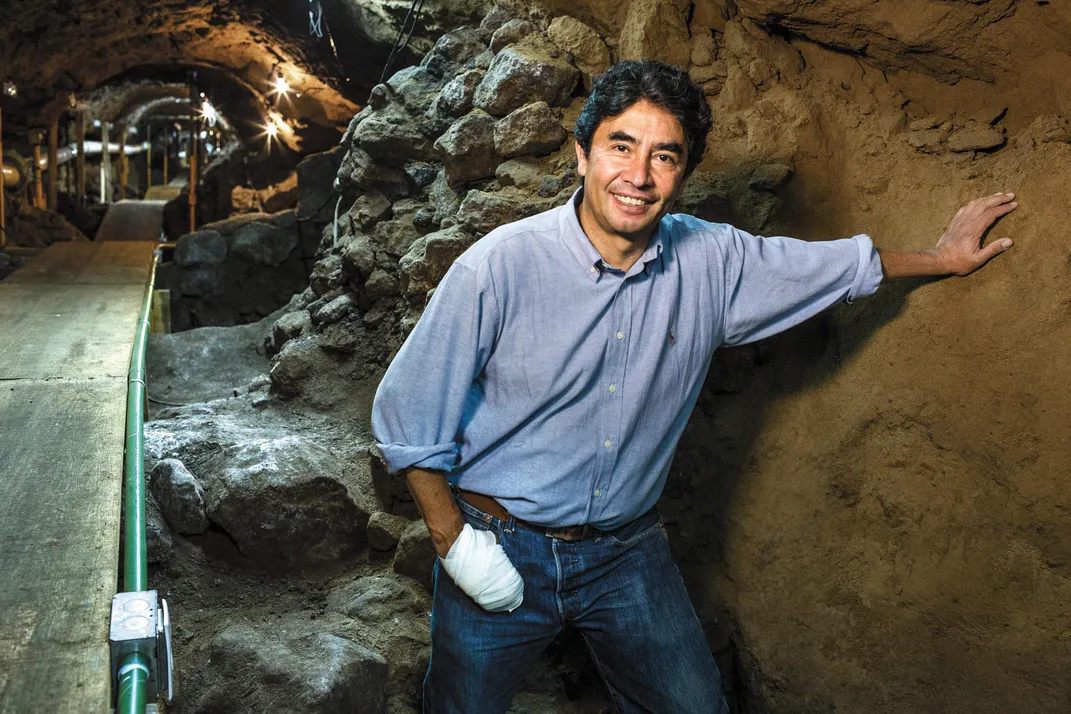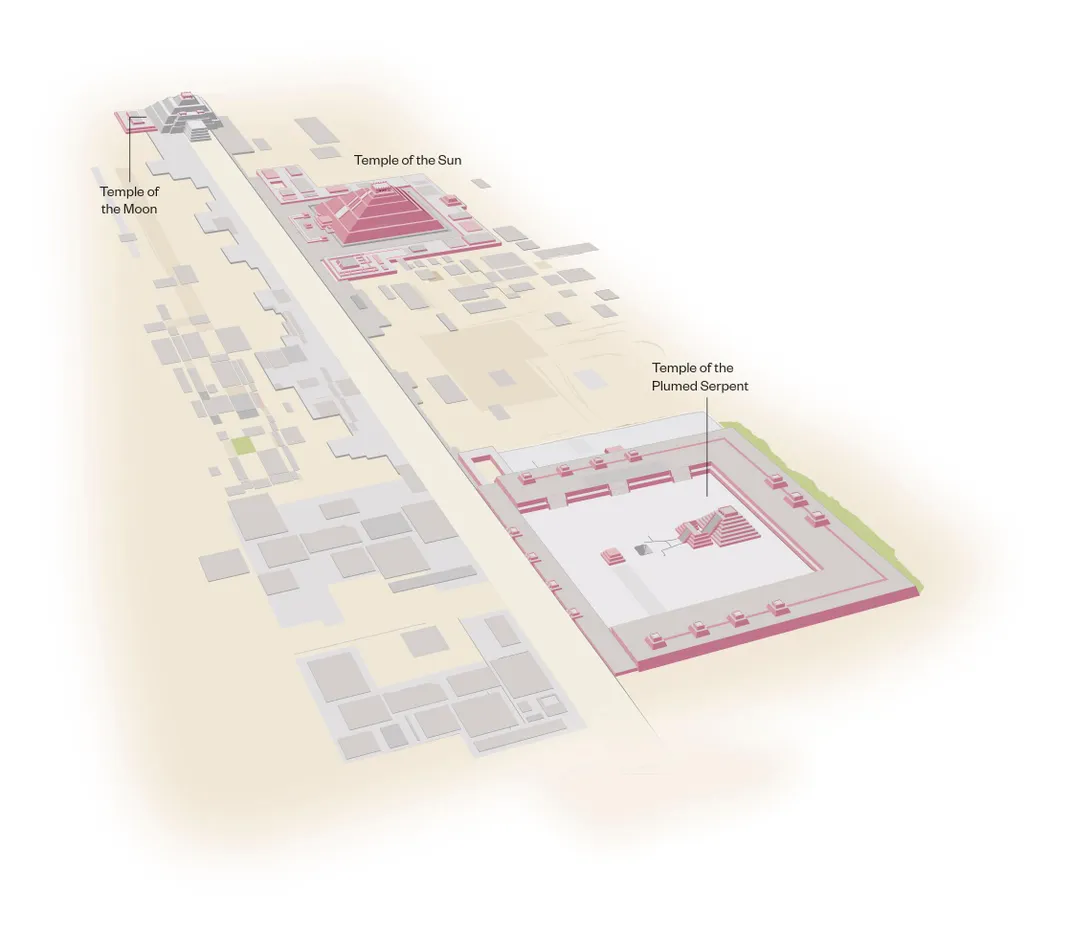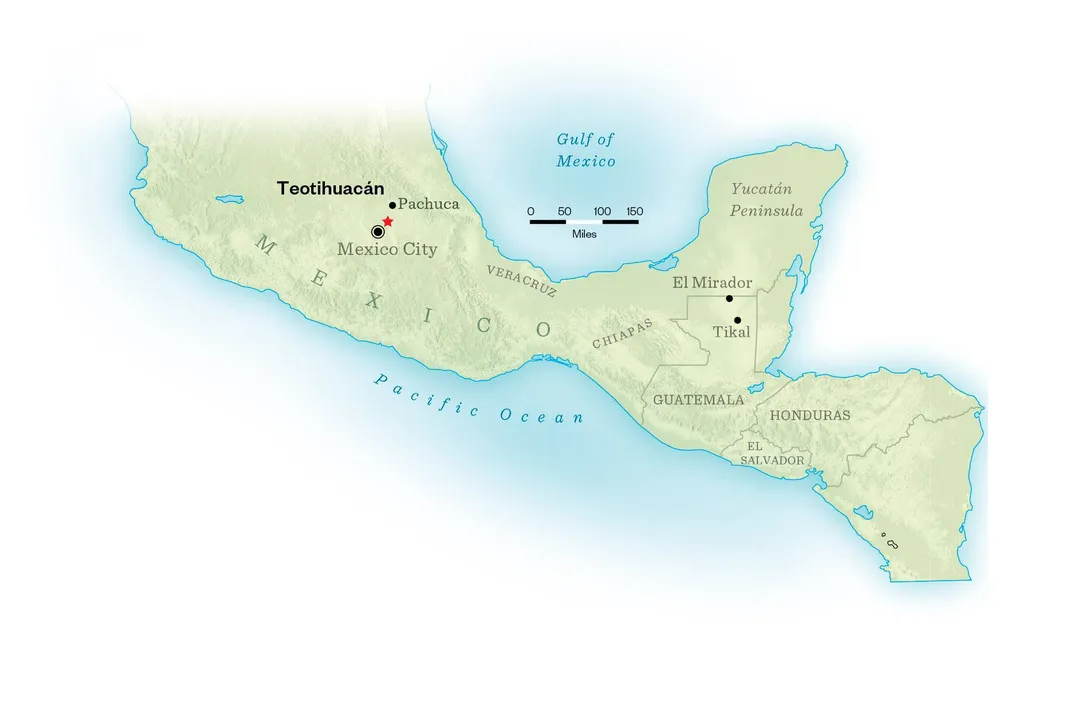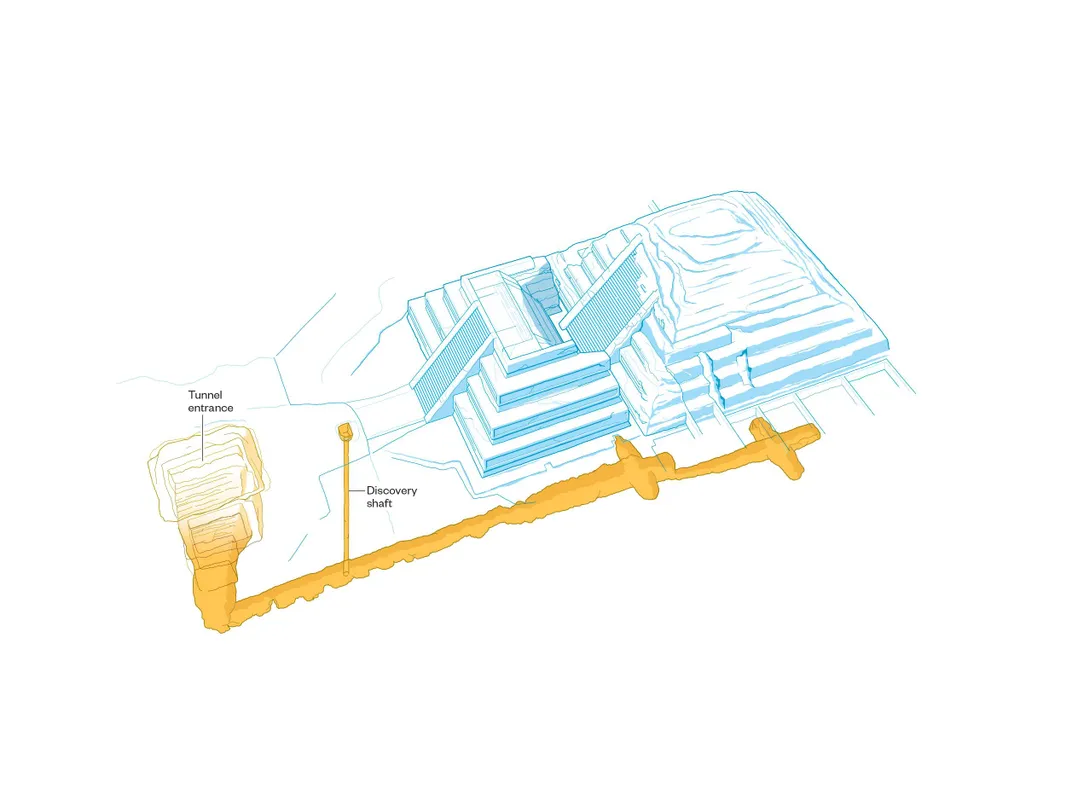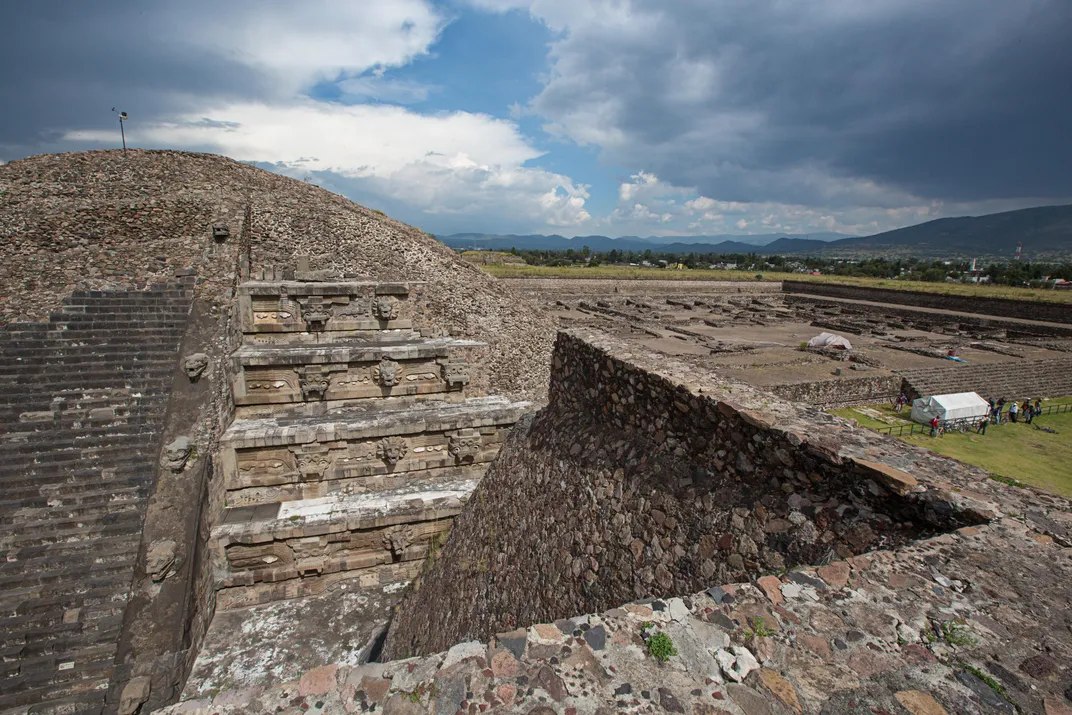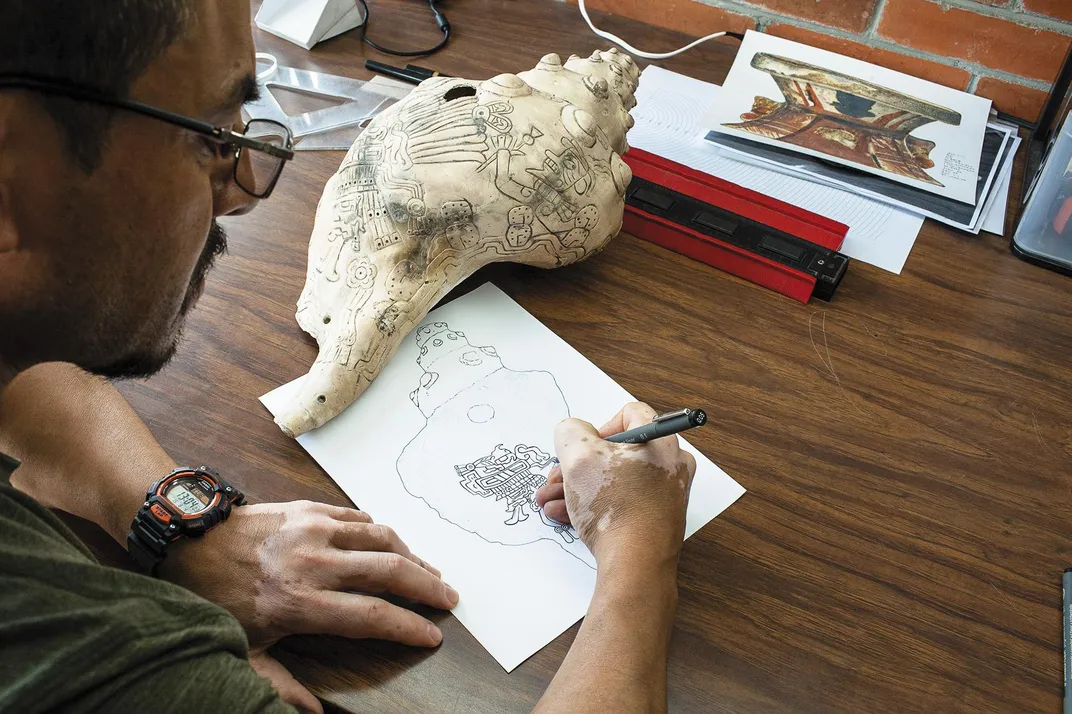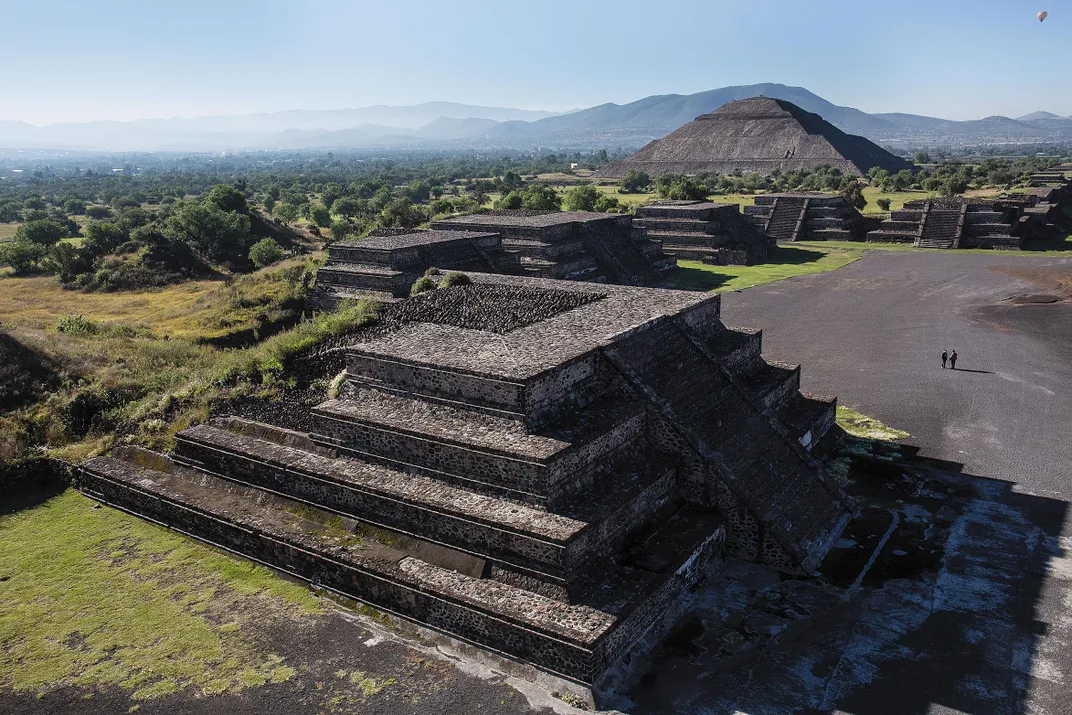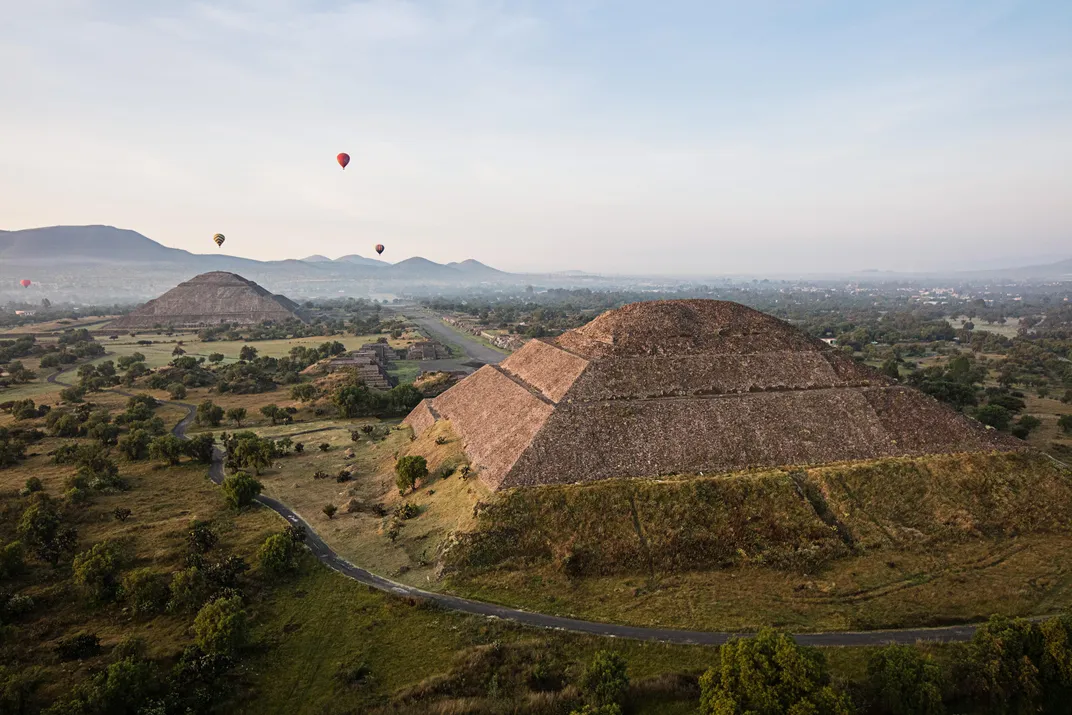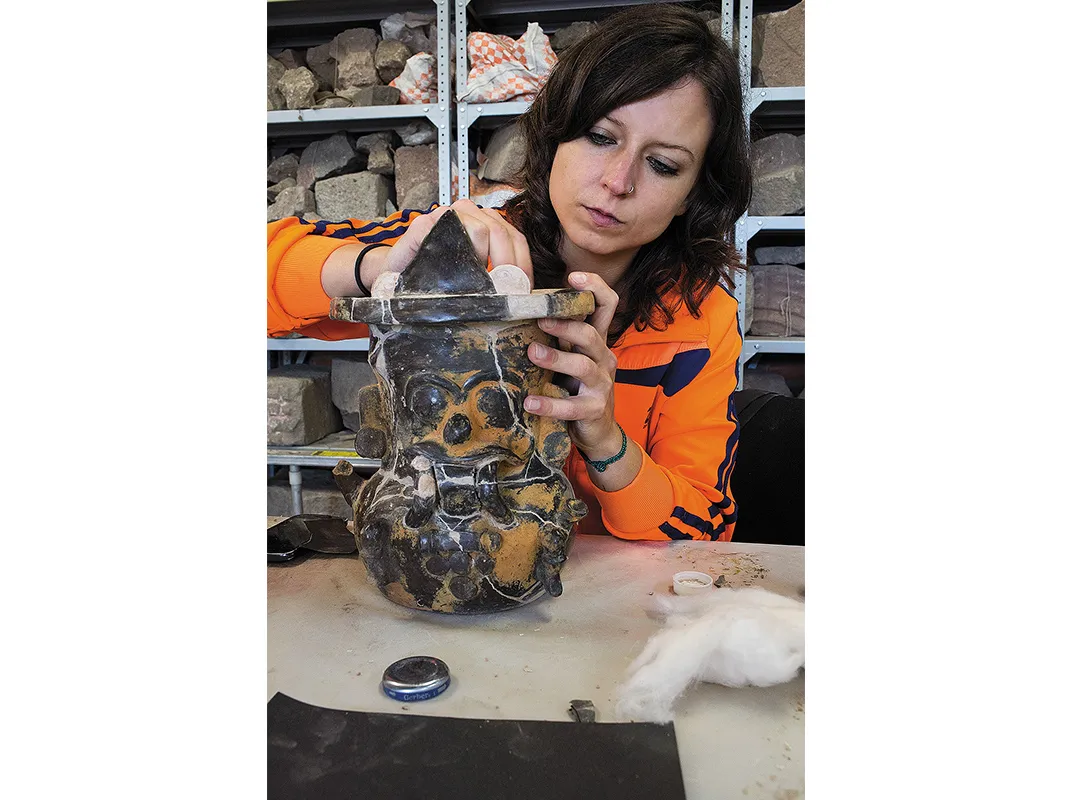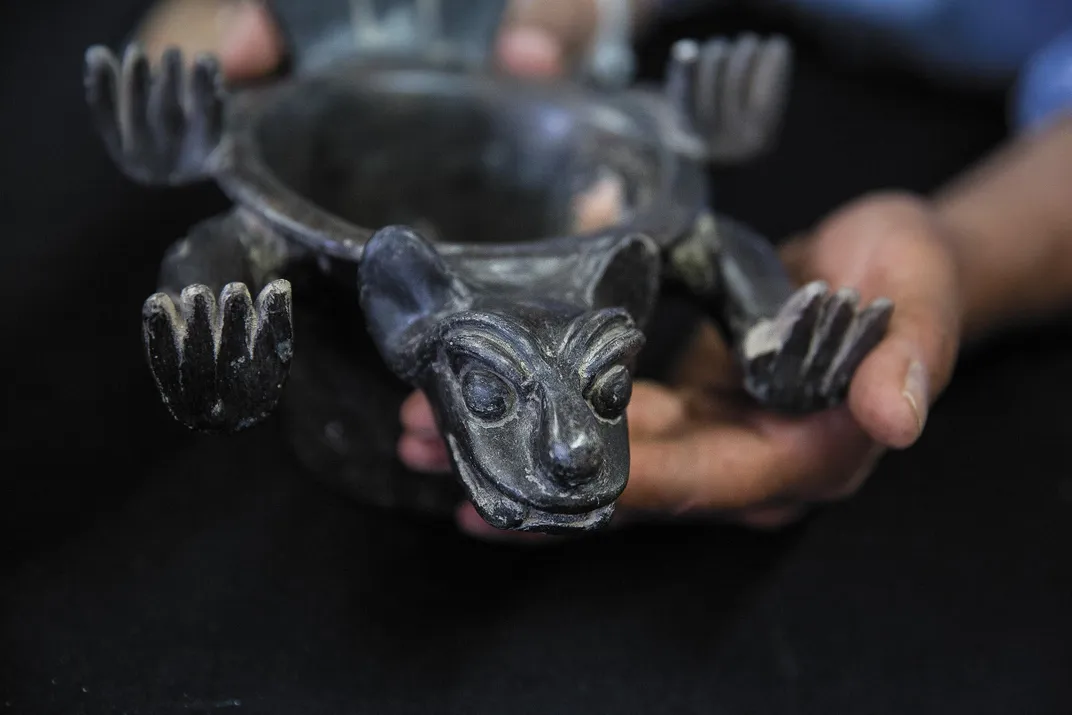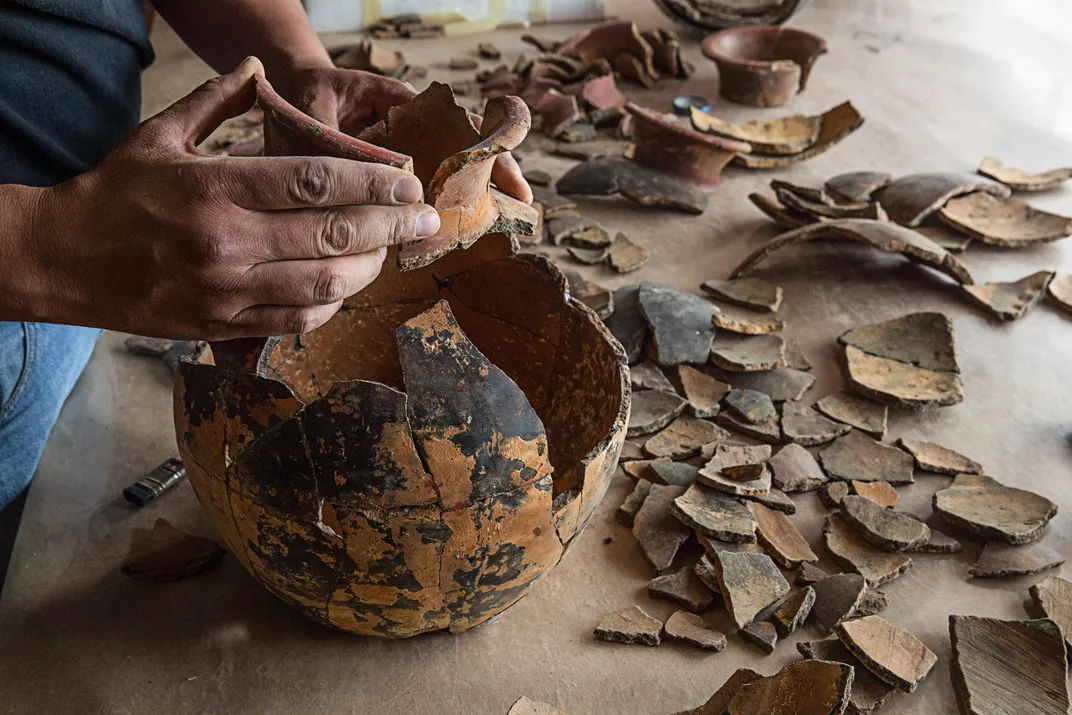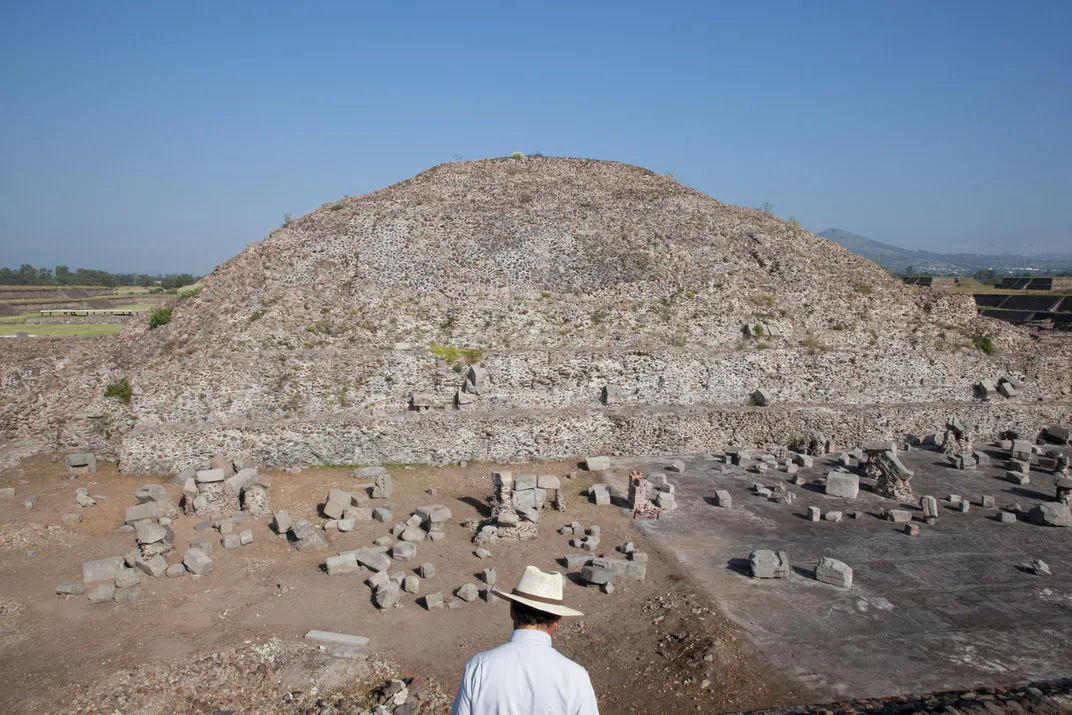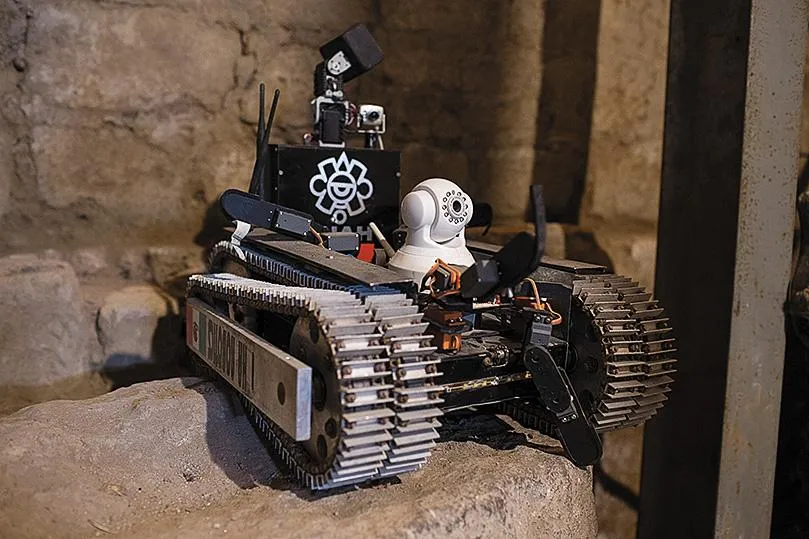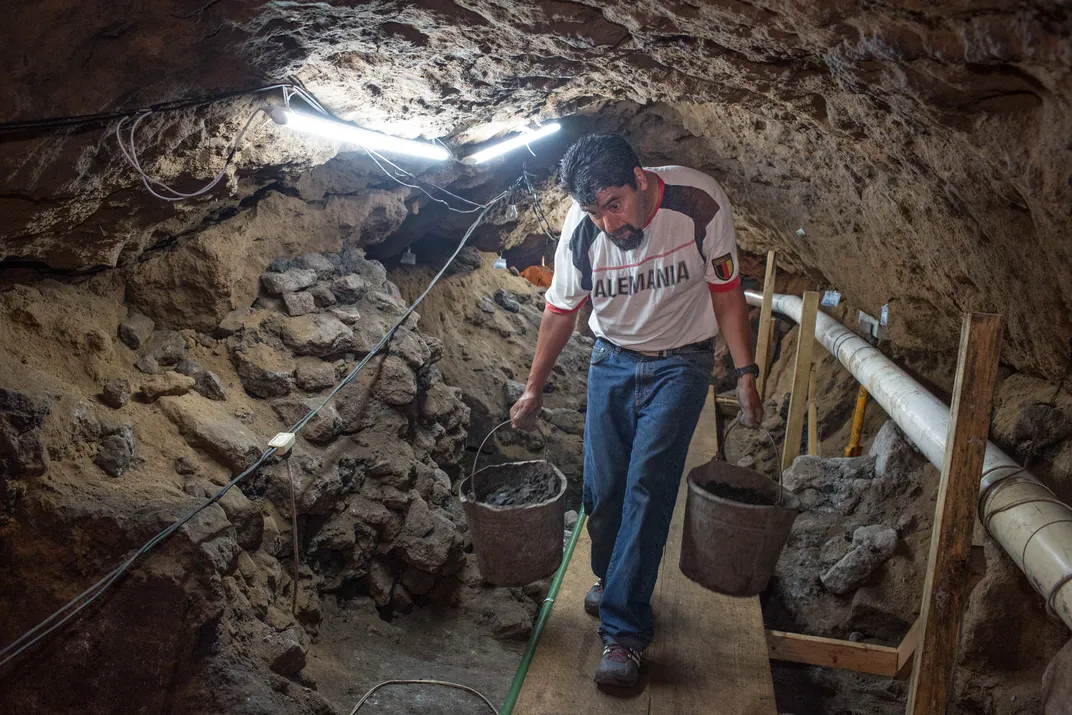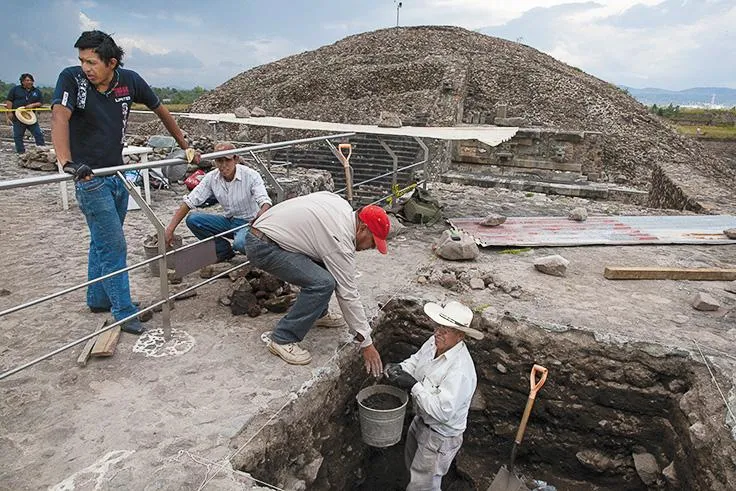A Secret Tunnel Found in Mexico May Finally Solve the Mysteries of Teotihuacán
The chance discovery beneath a nearly 2,000-year-old pyramid leads to the heart of a lost civilization
/https://tf-cmsv2-smithsonianmag-media.s3.amazonaws.com/filer/ba/4d/ba4d1156-8c5c-4bab-8a01-63e8e4ed5a9b/jun2016_c03_teotihuacan.jpg)
In the fall of 2003, a heavy rainstorm swept through the ruins of Teotihuacán, the pyramid-studded, pre-Aztec metropolis 30 miles northeast of present-day Mexico City. Dig sites sloshed over with water; a torrent of mud and debris coursed past rows of souvenir stands at the main entrance. The grounds of the city’s central courtyard buckled and broke. One morning, Sergio Gómez, an archaeologist with Mexico’s National Institute of Anthropology and History, arrived at work to find a nearly three-foot-wide sinkhole had opened at the foot of a large pyramid known as the Temple of the Plumed Serpent, in Teotihuacán’s southeast quadrant.
“My first thought was, ‘What exactly am I looking at?’” Gómez told me recently. “The second was, ‘How exactly are we going to fix this?’”
Gómez is wiry and small, with pronounced cheekbones, nicotine-stained fingers and a helmet of dense black hair that adds a couple of inches to his height. He has spent the past three decades—almost all of his professional career—working in and around Teotihuacán, which once, long ago, served as a cosmopolitan center of the Mesoamerican world. He is fond of saying that there are few living humans who know the place as intimately as he does.
And as far as he was concerned, there wasn’t anything beneath the Temple of the Plumed Serpent beyond dirt, fossils and rock. Gómez fetched a flashlight from his truck and aimed it into the sinkhole. Nothing: only darkness. So he tied a line of heavy rope around his waist and, with several colleagues holding onto the other end, he descended into the murk.
Gómez came to rest in the middle of what appeared to be a man-made tunnel. “I could make out some of the ceiling,” he told me, “but the tunnel itself was blocked in both directions by these immense stones.”
In designing Teotihuacán (pronounced tay-oh-tee-wah-KAHN), the city’s architects had arranged the major monuments on a north-south axis, with the so-called “Avenue of the Dead” linking the largest structure, the Temple of the Sun, with the Ciudadela, the southeasterly courtyard that housed the Temple of the Plumed Serpent. Gómez knew that archaeologists had previously discovered a narrow tunnel underneath the Temple of the Sun. He theorized that he was now looking at a kind of mirror tunnel, leading to a subterranean chamber beneath the Temple of the Plumed Serpent. If he was correct, it would be a find of stunning proportions—the type of achievement that can make a career.
“The problem was,” he told me, “you can’t just dive in and start tearing up earth. You have to have a clear hypothesis, and you have to get approval.”
Gómez set about making his plans. He erected a tent over the sinkhole, to keep it away from the prying eyes of the hundreds of thousands of tourists who visit Teotihuacán each year, and with the help of the National Institute of Anthropology and History arranged for the delivery of a lawnmower-size, high-resolution, ground-penetrating radar device. Beginning in the early months of 2004, he and a handpicked team of some 20 archaeologists and workers scanned the earth under the Ciudadela, returning every afternoon to upload the results to Gómez’s computers. By 2005, the digital map was complete.
As Gómez had suspected, the tunnel ran approximately 330 feet from the Ciudadela to the center of the Temple of the Plumed Serpent. The hole that had appeared during the 2003 storms was not the actual entrance; that lay a few yards back, and it had apparently been intentionally sealed with large boulders nearly 2,000 years ago. Whatever was inside that tunnel, Gómez thought to himself, was meant to stay hidden forever.
**********
Teotihuacán has long stood as the greatest of Mesoamerican mysteries: the site of a colossal and influential culture about which frustratingly little is understood, from the conditions of its rise to the circumstances of its collapse to its actual name. Teotihuacán translates as “the place where men become gods” in Nahuatl, the language of the Aztecs, who likely found the ruins of the deserted city sometime in the 1300s, centuries after its abandonment, and concluded that a powerful ur-culture—an ancestor of theirs—must have once resided in its vast temples.
The city lies in a basin at the southernmost edge of the Mexican Plateau, an undulating landmass that forms the spine of modern-day Mexico. Inside the basin the climate is mild, the land riven by streams and rivers—ideal conditions for farming and raising livestock.
Teotihuacán itself was likely settled as early as 400 B.C., but it was only around A.D. 100, an era of robust population growth and increased urbanization in Mesoamerica, that the metropolis as we know it, with its wide boulevards and monumental pyramids, was built. Some historians have theorized that its founders were refugees driven north by the eruption of a volcano. Others have speculated that they were Totonacs, a tribe from the east.
Whatever the case, the Teotihuacanos, as they are now known, proved themselves to be skilled urban planners. They built stone-sided canals to reroute the San Juan River directly under the Avenue of the Dead, and set about constructing the pyramids that would form the city’s core: the Temple of the Plumed Serpent, the even larger 147-foot-tall Temple of the Moon and the bulky, sky-obscuring 213-foot-tall Temple of the Sun.
Clemency Coggins, a professor emerita of archaeology and art history at Boston University, has suggested that the city was designed as a physical manifestation of its founders’ creation myth. “Not only was Teotihuacán laid out in a measured rectangular grid, but the pattern was oriented to the movement of the sun, which was born there,” Coggins has written. She is far from the only historian to see the city as large-scale metaphor. Michael Coe, an archaeologist at Yale, argued in the 1980s that individual structures might be representations of the emergence of humankind out of a vast and tumultuous sea. (As is in Genesis, Mesoamericans of the time are thought to have envisioned the world as being born from complete darkness, in this case aqueous.) Consider the Temple of the Plumed Serpent, Coe suggested—the same temple that hid Sergio Gómez’s tunnel. The structure’s facade was splashed with what Coggins called “marine motifs”: shells and what appear to be waves. Coe wrote that the temple represents the “initial creation of the universe from a watery void.”
Recent evidence suggests that the religion practiced in these pyramids bore a resemblance to the religion practiced in the contemporaneous Mayan cities of Tikal and El Mirador, hundreds of miles to the southeast: the worshiping of the sun and moon and stars; the veneration of a Quetzalcoatl-like plumed serpent; the frequent occurrence, in painting and sculpture, of a jaguar that doubles as deity and protector of men.
Yet peaceful ritual was apparently not always enough to sustain the Teotihuacanos’ connection to their gods. In 2004, Saburo Sugiyama, an anthropologist from the University of Japan and Arizona State University, who has spent decades studying Teotihuacán, and Rubén Cabrera, of Mexico’s National Institute of Anthropology and History, located a vault under the Temple of the Moon that held the remains of an array of wild animals, including jungle cats and eagles, along with 12 human corpses, ten missing their heads. “It is hard to believe that the ritual consisted of clean symbolic performances,” Sugiyama said at the time. “It is most likely that the ceremony created a horrible scene of bloodshed with sacrificed people and animals.”
Between A.D. 150 and 300, Teotihuacán grew rapidly. Locals harvested beans, avocados, peppers and squash on fields raised in the middle of shallow lakes and swampland—a technique known as chinampa—and kept chickens and turkeys. Several heavily trafficked trade routes were established, linking Teotihuacán to obsidian quarries in Pachuca and cacao groves near the Gulf of Mexico. Cotton came in from the Pacific Coast, ceramics from Veracruz.
By A.D. 400, Teotihuacán had become the most powerful and influential city in the region. Residential neighborhoods sprang up in concentric circles around the city center, eventually comprising thousands of individual family dwellings, not dissimilar to single-story apartments, that together may have housed 200,000 people.
Recent fieldwork by scholars like David Carballo, of Boston University, has revealed the sheer diversity of the citizenry of Teotihuacán: Judging by artifacts and paintings found inside surviving structures, residents came to Teotihuacán from as far afield as Chiapas and the Yucatán. There were likely Mayan neighborhoods, and Zapotec ones. As the scholar Miguel Angel Torres, an official at Mexico’s National Institute for Anthropology and History, told me recently, Teotihuacán was probably one of the first major melting pots in the Western Hemisphere. “I believe that the city grew a little like modern Manhattan,” Torres says. “You walk around through these different neighborhoods: Spanish Harlem, Chinatown, Koreatown. But together, the city functions as one, in harmony.”
The harmony did not last. There is a hint, in the demolition of some of the sculptures that adorn the temples and monuments, of periodic regime change in the ruling class of Teotihuacán; and, in the depiction of shield- and spear-toting warriors, of clashes with other local city-states. Perhaps, as several archaeologists suggested to me, civil war swept through Teotihuacán, culminating in a fire that seems to have damaged vast sections of the interior of the city around A.D. 550. Perhaps the fire was caused by a visiting army. Perhaps a large-scale migration occurred.
In A.D. 750, nearly 700 years after it was established, the city of Teotihuacán was abandoned, its monuments still filled with treasures and artifacts and bones, its buildings left to be eaten by the surrounding brush. The former residents of Teotihuacán, if they were not killed, were presumably absorbed into the populations of neighboring cultures, or returned along the established trade routes to the lands where their ancestral kin still lived throughout the Mesoamerican world.
They took their secrets with them. Today, even after more than a century of excavation at the site, there is an extraordinary amount we do not know about the Teotihuacanos. They did have some kind of quasi-hieroglyphic written language, but we haven’t cracked it; we don’t know what tongue was spoken inside the city, or even what the natives called the place. We have a conception of the religion they practiced, but we don’t know much about the priestly class, or the relative piety of the city’s citizenry, or the makeup of the courts or the military. We don’t know exactly what led to the city’s founding, or who ruled over it during its half-millennium of dominance, or what exactly caused its fall. As Matthew Robb, the curator of Mesoamerican art at San Francisco’s de Young Museum, told me, “This city wasn’t designed to answer our questions.”
In archaeology and anthropology circles—to say nothing of the popular press—Sergio Gómez’s discovery was greeted as a major turning point in Teotihuacán studies. The tunnel under the Temple of the Sun had been largely emptied by looters before archaeologists could get to it in the 1990s. But Gómez’s tunnel had been sealed off for some 1,800 years: Its treasures would be pristine.
In 2009, the government granted Gómez permission to dig, and he broke ground at the entrance of the tunnel, where he installed a staircase and ladders that would allow easy access to the subterranean site. He moved at a painstaking pace: inches at a time, a few feet every month. Excavating was done manually, with spades. Nearly 1,000 tons of earth were removed from the tunnel; after each new segment was cleared, Gómez brought in a 3-D scanner to document his progress.
The haul was tremendous. There were seashells, cat bones, pottery. There were fragments of human skin. There were elaborate necklaces. There were rings and wood and figurines. Everything was deposited deliberately and pointedly, as if in offering. The picture was coming into focus for Gómez: This was not a place where ordinary residents could tread.
A university in Mexico City donated a pair of robots, Tlaloque and Tláloc II, playfully named for Aztec rain deities whose images appear in early iterations throughout Teotihuacán, to inspect deeper inside the tunnel, including the final stretch, which descended, on a ramp, an extra ten feet into the earth. Like mechanical moles, the robots chewed through the soil, their camera lights aglow, and returned with hard drives full of spectacular footage: The tunnel seemed to end in a spacious cross-shaped chamber, piled high with more jewelry and several statues.
It was here, Gómez hoped, that he’d make his biggest find yet.
**********
I met Gómez late last year, on a smoldering afternoon. He was smoking a cigarette and drinking coffee out of a foam cup. Tides of tourists swept to and fro over the grass of the Ciudadela—I heard scraps of Italian, Russian, French. An Asian couple stopped to peer in at Gómez and his team as if they were tigers at a zoo. Gómez looked back stonily, the cigarette hanging off his bottom lip.
Gómez told me about the work his team was doing to study the 75,000 or so artifacts they had already found, each of which needed to be carefully cataloged, analyzed and, when possible, restored. “I would estimate that we’re only about 10 percent through the process,” he said.
The restoration operation is set up in a cluster of buildings not far from the Ciudadela. In one room, a young man was sketching artifacts and noting where in the tunnel the objects had been found. Next door, a handful of conservators sat at a banquet-style table, bent over an array of pottery. The air smelled sharply of acetone and alcohol, a mixture used to remove contaminants from the artifacts.
“It might take you months just to finish a single large piece,” Vania García, a technician from Mexico City, told me. She was using a syringe primed with acetone to clean a particularly tiny crack. “But some of the other objects are remarkably well preserved: They were buried carefully.” She recalled that not long ago, she found a powdery yellow substance at the bottom of a jar. It was corn, it turned out—1,800-year-old corn.
Passing through a lab where wood recovered from the tunnel was being carefully treated in chemical baths, we stepped into the storeroom. “This is where we keep the fully restored artifacts,” Gómez said. There was a statue of a coiled jaguar, poised to pounce, and a collection of flawless obsidian knives. The material for the weapons had probably been brought in from the Pachuca region of Mexico and carved in Teotihuacán by master craftspeople. Gómez held out a knife for me to hold; it was marvelously light. “What a society, no?” he exclaimed. “That could create something as beautiful and powerful as that.”
In the canvas tent erected over the entrance to the tunnel, Gómez’s team had installed a ladder that led down into the earth—a wobbly thing fastened to the top platform with frayed twine. I descended carefully, foot over foot, the brim of my hard hat slipping over my eyes. In the tunnel it was damp and cold, like a grave. To get anywhere, you had to walk on your haunches, turning to the side when the passage narrowed. As protection against cave-ins, Gómez’s workmen had installed several dozen feet of scaffolding—the earth here is unstable, and earthquakes are common. So far, there had been two partial collapses; no one had been hurt. Still, it was hard not to feel a shiver of taphophobia.
Through the middle of Teotihuacán studies runs a division like a fault line, separating those who believe that the city was ruled by an all-powerful and violent king and those who argue that it was governed by a council of elite families or otherwise bound groups, vying over time for relative influence, arising from the cosmopolitan nature of the city itself. The first camp, which includes experts like Saburo Sugiyama, has precedent on its side—the Maya, for instance, are famous for their warlike kings—but unlike Mayan cities, where rulers had their visages festooned on buildings and where they were buried in opulent tombs, Teotihuacán has offered up no such decorations, nor tombs.
Initially, much of the buzz surrounding the tunnel beneath the Temple of the Plumed Serpent centered on the possibility that Gómez and his colleagues might finally locate one such tomb, and thereby solve one of the city’s most fundamental enduring mysteries. Gómez himself has entertained the idea. But as we clambered through the tunnel, he laid out a hypothesis that seemed to stem more directly from the mythological readings of the city laid out by scholars like Clemency Coggins and Michael Coe.
Fifty feet in, we stopped at a small inlet carved into the wall. Not long before, Gómez and his colleagues had discovered traces of mercury in the tunnel, which Gómez believed served as symbolic representations of water, as well as the mineral pyrite, which was embedded in the rock by hand. In semi-darkness, Gómez explained, the shards of pyrite emit a throbbing, metallic glow. To demonstrate, he unscrewed the nearest light bulb. The pyrite came to life, like a distant galaxy. It was possible, in that moment, to imagine what the tunnel’s designers might have felt more than a thousand years ago: 40 feet underground, they’d replicated the experience of standing amid the stars.
If, Gómez suggested, it was true that the layout of the city proper was meant to stand in for the universe and its creation, might the tunnel, beneath the temple devoted to an all-encompassing aqueous past, represent a world outside of time, an underworld or a world before, not the world of the living but of the dead? Up above, there was the Temple of the Sun and the eternal day. Down below, the stars—not of this earth—and the deepest night.
I followed Gómez down a short ramp and into the cross-shaped chamber directly under the heart of the Temple of the Plumed Serpent. Four archaeologists were kneeling in the dirt, brushes and thin-bladed trowels in hand. A nearby boombox blared Lady Gaga.
Gómez told me he had not been prepared for the sheer diversity of the objects he encountered in the farthermost reaches of the tunnel: necklaces, with the string intact. Boxes of beetle wings. Jaguar bones. Balls of amber. And perhaps most intriguingly, a pair of finely carved black stone statues, each facing the wall opposite to the entryway of the chamber.
Writing in the late 1990s, Coggins speculated that religious tradition at Teotihuacán would have been “perpetuated in the linked repetition of ritual,” likely on the part of a priesthood. That ritual, Coggins went on, “would have concerned the Creation, Teotihuacán’s role in it, and probably also the birth/emergence of the Teotihuacán people from a cave”—a deep and dark hole in the earth.
Gómez gestured at the area where the twin figures once stood. “You can imagine a scenario where priests come down here to pay tribute to them,” he explained—to the Creators of the universe, and of the city, one and the same.
Gómez has one more crucial task to undertake: the excavation of three distinct, buried sub-chambers located below the resting place of the figurines, the final sections of the tunnel complex as yet unexplored. Some scholars speculate that the elaborate ritual offerings on display here, and the presence of pyrite and mercury, which held known associations with the supernatural among ancient Mesoamericans, provide further evidence that the buried sub-chambers represent the entryway to a particular type of underworld: the place where the city’s ruler departed the world of the living. Others argue that even the discovery of long-sought human remains buried in spectacular fashion would hardly close the book on the mystery of Teotihuacán’s rulers: Whoever is buried here could be just one ruler among many, perhaps even some other kind of holy person.
For Gómez, the sub-chambers, whether they are filled with more ritual relics, or remains, or something entirely unexpected, might be best understood as a symbolic “tomb”: a final resting place for the city’s founders, of gods and men.
A few months after leaving Mexico, I checked in with Gómez. He was only marginally closer to uncovering the chambers beneath the end of the tunnel. His archaeologists were literally often working with toothbrushes, so as not to damage whatever lay beneath.
Regardless of what he found at the end of the tunnel, once his excavation was complete, he promised me, he’d be satisfied. “The number of artifacts we’ve uncovered,” he said, pausing. “You could spend a whole career evaluating the contents.”
Related Reads
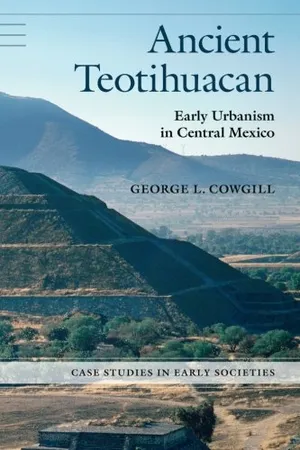
Ancient Teotihuacán: Early Urbanism in Central Mexico
